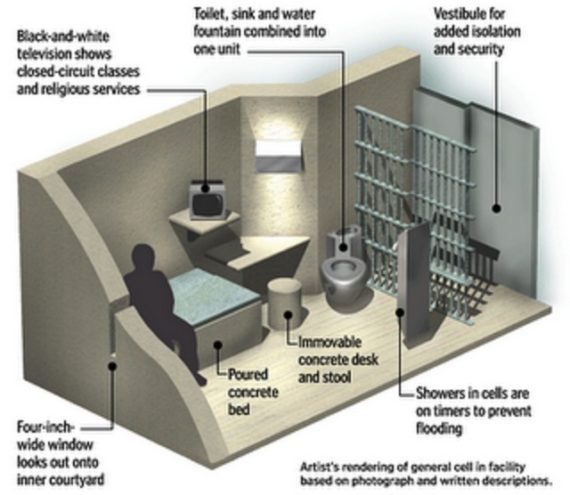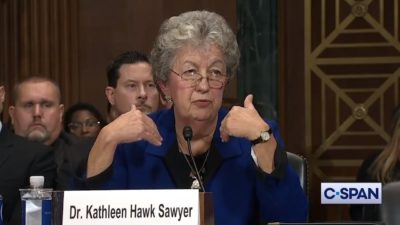
Seriously mentally ill prisoners held by the federal Bureau of Prisons are no longer supposed to be housed in isolation cells such as this example.
(3-09-20) Government advisory committees do exactly that. They advise. There’s no guarantee anyone will listen. Agencies have their own experts and priorities, and so do the political appointees appointed by the president to run them.
I understood this when I was appointed to serve on the newly created Interdepartmental Serious Mental Illness Coordinating Committee (ISMICC), which was created by Congress to foster collaboration and communication between the nine federal departments and agencies that deal with more than a hundred mental health/substance abuse programs.
With support from my fellow non-federal board members, I have focused on the federal Bureau of Prisons (BOP) and our panel’s recommendation that it find ways to reduce long term isolation and restraints when dealing with seriously mentally ill patients.
While the Justice Department was required to participate in ISMICC, Congress didn’t mention the BOP. This was unfortunate because the federal prison system houses 175,315 prisoners, including several who have serious mental illnesses (most notably Ted Kaczynski, the Unabomber.)
Sadly, the BOP has a dismal record when it comes to its treatment of seriously mentally ill inmates. In July 2017, the Justice Department’s Office of Inspector General found that on average, BOP prisoners with serious mental illnesses were confined about 896 consecutive days, or about 29 months, in so-called “special management units (isolation)” between 2008 and 2015. Incredibly, 13% of these inmates were released directly into the community after spending an average of 29 consecutive months in seclusion cells with minimal treatment. A study by the Marshall Project a year later questioned claims by the BOP that it was enacting changes to improve mental health care and took issue with the BOP’s claim that only three percent of its prisoners had a mental illness. The general accepted statistic is that 16 percent of incarcerated individuals have a diagnosed mental illness.
Twelve of my fellow non-federal ISMICC members joined me (only one didn’t sign on) in asking the BOP Director to begin participating in ISMICC meetings. The then-director agreed but he ended up being replaced last year and the BOP delegate missed our last two meetings.
Undaunted, thirteen of us sent a second letter requesting BOP participation to its new director, Kathleen Hawk Sawyer.
I was optimistic because I had encountered Hawk Sawyer in the 1980s when I was doing research for my book, The Hot House: Life Inside Leavenworth Prison, having been given unlimited access to spend a year as a reporter inside a federal penitentiary. A trained psychologist, Hawk Sawyer served as the Chief of the BOP’s Psychological Services in the 1980s and eventually became the first woman to head the male dominated agency when she was named its director in 1992. She served as director until 2003 when she retired only to be brought back in August 2019 because the bureau needed a veteran’s steady hand. (Director Mark Inch abruptly resigned after tangling with the White House.)
On February 24, 2020, Director Hawk Sawyer sent me a letter addressing the concerns that 13 of us had raised about the BOP’s lack of ISMICC participation.
 “As the Director and as a psychologist, I am aware of the challenges individuals with mental illness can face in prison and the positive difference treatment can make in their lives,” she wrote.
“As the Director and as a psychologist, I am aware of the challenges individuals with mental illness can face in prison and the positive difference treatment can make in their lives,” she wrote.
Continuing, she wrote:
“The BOP is committed to reducing the use of restrictive housing, especially for inmates with serious mental illness…We have made significant strides in this area. For example,:
All inmates with serious mental illness are screened by a psychologist within 24 hours of entering a restrictive housing setting to ensure their safety and identify alternatives, if appropriate.
All inmates referred to (higher level isolation units) are screened by psychologists in the Central Office (Washington) and those with serious mental illness are precluded from placement in these settings.
BOP has implemented effective strategies to monitor inmates for emerging mental illness in restrictive housing and to remove them promptly, if necessary.
BOP added three secure mental health programs over the last seven years to divert inmates with serious mental illness from restrictive housing and provide intensive treatment.
In November, 2019, I approved three additional secure mental health programs that will activate over the next two years, providing intensive treatment opportunities to inmates with serious mental illness outside of restrictive housing.
In December, 2019, I approved 10 reintegration unites to hold inmates in protective custody status, including those with mental illness, in safe, open unites with work, program, and treatment opportunities.
In December, 2019, I approved the BOP’s second Female Integration Treatment Program to provide residential treatment, including mental health treatment, to female inmates.
Director Hawk Sawyer concluded: “the BOP is working diligently to reduce the use of restrictive housing for individuals with serious mental illness.” She also assured us the BOP would actively participate in future ISMICC meetings.
Those of us who have had a family member in a jail or prison know how easily it is for them to be put in isolation and restraints. We also know how damaging that can be – exasperating their illnesses.
All of us appreciated Director Sawyer’s response and her update.
The day after she wrote her letter to me, Attorney General William S. Barr appointed a new director to replace her.
Michael Carvajal first joined the BOP in 1992 as a correctional officer. He has no psychological training. He is now in charge.
Time will tell whether he will follow through on Hawk Sawyer’s efforts and pledge to reduce long term isolation and restraints.
Let’s hope so.



